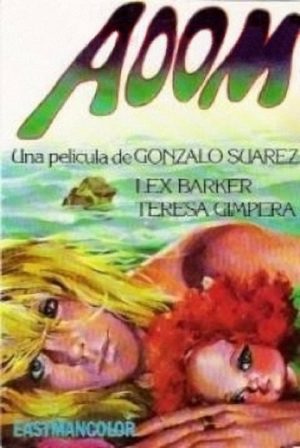 “Aoom” is apparently “that noise you hear when there is no sound.” So we’re informed at the beginning of this weirder-than-average 1970 feature by Spain’s Gonzalo Suarez, a worthy addition to a distinguished filmography (which includes bizarre features like THE STRANGE CASE OF DR. FAUSTO and DON JUAN IN HELL).
“Aoom” is apparently “that noise you hear when there is no sound.” So we’re informed at the beginning of this weirder-than-average 1970 feature by Spain’s Gonzalo Suarez, a worthy addition to a distinguished filmography (which includes bizarre features like THE STRANGE CASE OF DR. FAUSTO and DON JUAN IN HELL).
Ristol (Lex Barker) is a famous actor who, as we learn in the opening narration, has transcended reality in favor of some astral plain. To the world at large he’s deceased, but his lover Ana (Teresa Gimpera) refuses to believe it.
Ana heads to the scenic Cliffside villa where Ristol liked to cavort, and meets up with his eccentric servant Constantino (Luis Ciges). Together with two young lovers residing nearby, Ana and Constantino go in search of a witch who dwells in the wilderness bordering the villa. The journey disgorges a number of frightful creature statues, and also the witch herself, a spastic young woman (Gila Hodgkinson) who seems incapable of sitting still.
Ana unwisely invites the woman back to the villa, and the atmosphere turns poisonous as Ana, Williams and their companions increasingly give themselves over to licentiousness and debauchery. Ana, however, refuses to abandon her search for Ristol, and organizes another expedition the following morning. This search centers on a seaside cave where Ana gets lost and a crazy man (Julian Ugarte) is found. The latter kills a local woman for no evident reason, around which time the Aoom sound is heard by Ana and co.
Flashbacks, triggered by tape recorded musings Ristol has left behind, show Ristol when he was alive, playing with a doll and pondering the query “What if I was nothing, nothing at all?” His ultimate goal is to project his spirit into his beloved doll. This he does, but can’t seem to make the journey back to his body. He can, at least, mentally communicate with Constantino, who takes the doll and rips it apart, before throwing its remains into the sea. But Ristol’s spirit is still extant, and needs to find a new vessel…
This film is very much a product of its time, meaning the psychedelic visuals often take precedence over narrative clarity, a tendency that’s especially noticeable in the voice-overs by some never-seen individual that are extensively employed in the first few minutes to set things up. Also in keeping with the tenor of the time, Gonzalo Suarez tends to favor fisheye lenses and seasickness-inducing camerawork (as in a dance sequence in which the camera bobs and weaves along with the actors), complimented by a highly asynchronous avant-garde score that rarely ever matches the imagery.
The result is an enormously silly and overwrought exercise in weirdness-for-weirdness’s sake that’s also curiously haunting and resonant. Unlike many other European filmmakers who got their start in 1960s experimentalism, Gonzalo Suarez had a genuine talent for filmic disorientation. His genius for expressive visual design is evident in the stunningly scenic Mediterranean seaside locations, which as depicted here are at once beautiful and deeply ominous. Also, this film contains what are very likely the most evocative doll face close-ups ever seen in a movie.
Vital Statistics
AOOM
Hersua Interfilms
Director: Gonzalo Suarez
Producer: Enrique Esteban
Screenplay: Gustavo Hernandez, Gonzalo Suarez
Cinematography: Francisco Marin
Editing: “Maricel” (Maricel Bautista)
Cast: Lex Barker, Teresa Gimpera, Julian Ugarte, Romy, Luis Ciges, Bill Dyckes, “Gila” (Gila Hodgkinson), Concha Duran, Fermin Mor, Antonio Duran
